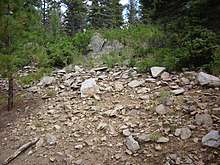Maquinita Granodiorite
The Maquinita Granodiorite is a Precambrian pluton that crops out in the northern Tusas Mountains of New Mexico. It has a radiometric age of 1.755 billion years, corresponding to the Statherian period.
| Maquinita Granodiorite Stratigraphic range: Statherian | |
|---|---|
 Maquinitas Grandodiorite on Hopewell Ridge, New Mexico | |
| Type | Pluton |
| Lithology | |
| Primary | Granodiorite |
| Location | |
| Coordinates | 36.703°N 106.159°W |
| Region | Tusas Mountains, New Mexico |
| Country | United States |
| Type section | |
| Named for | Maquinita Canyon |
| Named by | F. Barker |
| Year defined | 1958 |
 Maquinita Granodiorite (the United States)  Maquinita Granodiorite (New Mexico) | |
Overview
The formation takes the form of many small dikes and plutons intruding the Moppin Complex.[1] These consist of gray, homogeneous, well-foliated granodiorite. Its modal composition is 57% albite-oligoclase, 27% quartz, 10% biotite, 4% muscovite, and 1% each epidote and microcline. The foliation is defined by biotite knots, up to 2.5 cm in length. The rock appears moderately to strongly sheared. The feldspars have been moderately to thoroughly sericitized and mildly saussuritized. Much of the rock has been sheared to a fine-grained aggregate.[1] The unit contains xenoliths that appear to be Moppin Complex schists.[2]
The fabric (S1) generally strikes 090-110˚ and dips 70 to 90˚ to the south. No folds are visible.[3]
The formation has a uranium-lead radiometric age of 1.755 Gya, which establishes a minimum age for the Moppin Complex it intrudes that is typical of the Yavapai crustal province.[4]
Economic geology
Mineralization veins in the northern Tusas Mountains appear to be coeval with the Maquinita Granodiorite.[5]
History of investigation
Gray granodiorite in the northern Tusas Mountains was mapped by Evan Just in 1937, during his investigations of pegmatites, as part of the Tusas Granite.[6] The current designation was assigned by Fred Bauer during the geologic mapping of the Las Tablas area in 1958, who named it for outcrops in Maquinitas Canyon (36.6907°N 106.1747°W) [1]
Footnotes
- Barker 1958, p.56
- McLemore 2011, p. 381
- Davis et al. 2011, p. 182
- Bauer and Williams 1989, p.47
- McLemore 2011, p. 386
- Bingler 1974, p.111
References
- Barker, Fred (1958). "Precambrian and Tertiary geology of Las Tablas quadrangle, New Mexico" (PDF). New Mexico Bureau of Mines and Mineral Resources Bulletin. 45.
- Bauer, Paul W.; Williams, Michael L. (August 1989). "Stratigraphic nomenclature ol proterozoic rocks, northern New Mexico-revisions, redefinitions, and formaliza" (PDF). New Mexico Geology. 11 (3). Retrieved 15 April 2020.
- Bingler, E.C. (1974). "PRECAMBRIAN ROCKS OF THE TUSAS MOUNTAINS" (PDF). New Mexico Geologic Society Field Conference Series (25): 109–113. Retrieved 8 May 2020.
- Davis, Peter; Williams, Mike; Karlstrom, Karl (2011). "Structural evolution and timing of deformation along the Proterozoic Spring Creek shear zone of the northern Tusas Mountains, New Mexico" (PDF). New Mexico Geological Society Field Conference Series. 62: 177–190.
- McLemore, Virginia T. (2011). "Geology and mineral resources in the Hopewell and Bromide No. 2 districts, northern Tusas Mountains, Rio Arriba County, New Mexico" (PDF). New Mexico Geological Society Field Conference Series. 62: 379–388.